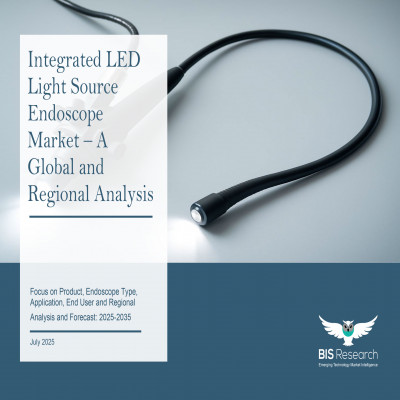Introduction to Europe Integrated LED Light Source Endoscope Market
The Europe integrated LED light source endoscope market is projected to reach $1,105.4 million by 2035 from $241.6 million in 2024, growing at a CAGR of 14.02% during the forecast period 2025-2035. The growing incidence of chronic illnesses, ongoing advancements in light source technology, and the region's aging population have all contributed to the impressive, nearly double-digit growth of the European integrated LED light source endoscope market.
Demand has increased recently as more healthcare providers use cutting-edge endoscopic procedures. A vital component of endoscopic systems, light sources allow doctors and surgeons to perform minimally invasive procedures by providing clear, high-quality visualization of inside organs. Compared to conventional xenon or halogen choices, LED-based integrated light sources offer higher brightness, a longer operational lifespan, lower heat emission, and enhanced energy efficiency. This move has had a revolutionary impact in Europe.
These technological advancements not only improve image quality and diagnostic accuracy, but they also improve patient safety, lower operating costs over time, and increase procedural efficiency. Because of this, the use of integrated LED systems is increasingly driving modernization in hospitals and surgical centers throughout Europe, and developments in lighting technology are significantly influencing the market's growth trajectory.
Market Introduction
The market for integrated LED light source endoscopes in Europe is growing quickly due to the continent's aging population, growing desire for minimally invasive operations, and technical advancements. Modern endoscopic systems require integrated LED light sources because they provide brilliant, reliable illumination that helps doctors precisely view inside structures. Longer operating lifespans, lower energy consumption, less heat generation, and improved image quality are all advantages of LED-based systems over conventional xenon or halogen units. These advantages are in line with Europe's drive for affordable and environmentally friendly healthcare technology.
The growing prevalence of chronic pulmonary, urological, and gastrointestinal conditions—all of which necessitate routine endoscopic diagnosis and treatment—further supports growth. Crucially, stringent regulatory frameworks like the EU Medical Device Regulation (MDR 2017/745), which imposes stringent safety, performance, and post-market surveillance standards, govern the European market. Manufacturers are now investing in high-quality, compatible LED-based solutions as a result of these rules. Although payment mechanisms and coverage differ by area, many EU nations—especially Germany, France, and the Nordic states—offer structured funding for endoscopic operations that are medically required. These elements, together with hospital modernization initiatives, infection control regulations, and a growing trend toward single-use devices, are driving the European market for integrated LED light source endoscopes toward steady and strong development.
Market Segmentation
Segmentation 1: by Endoscope Type
• Single-Use Endoscope
• Reusable Endoscope
Segmentation 2: by Region
• Europe
o Germany
o France
o U.K.
o Italy
o Spain
o Denmark
o Netherland
o Switzerland
o Rest-of-Europe
Europe Integrated LED Light Source Endoscope Market Trend, Drivers and Challenges
Market Trends
• Growing adoption of minimally invasive procedures across Europe, supported by better patient recovery times and reduced hospitalization needs.
• Shift towards integrated light source endoscopes with LED technology for enhanced image clarity, energy efficiency, and lower maintenance costs compared to xenon light sources.
• Increasing integration of robotics and AI into endoscopic systems for improved diagnostic accuracy and precision in interventions.
• Rising preference for single-use/disposable endoscopes to reduce hospital-acquired infection (HAI) risks.
• Technological advances in video and visualization systems driving higher diagnostic quality and adoption rates.
Key Growth Drivers
• Advantages of LED over traditional light sources (longer lifespan, lower heat emission, consistent light output).
• Increasing prevalence of chronic diseases (gastrointestinal, pulmonary, urological) necessitating more diagnostic and therapeutic endoscopic procedures.
• Growing geriatric population in Europe, which is more prone to conditions requiring endoscopic intervention.
• High risk and awareness of HAIs, boosting demand for sterile and efficient integrated systems.
• Regulatory approvals and compliance supporting market entry of advanced LED-based systems.
• Cost savings over time due to lower maintenance and replacement frequency of LED light sources.
Market Challenges
• Dominance of existing reusable endoscope enterprises slowing adoption of newer integrated LED solutions.
• High initial capital investment for advanced integrated systems, limiting uptake among smaller healthcare facilities.
• Shortage of skilled professionals to operate and maintain advanced endoscopic equipment.
• Reimbursement limitations in certain European countries, affecting purchasing decisions.
• Resistance to change from healthcare facilities heavily invested in existing xenon-based or halogen systems.

